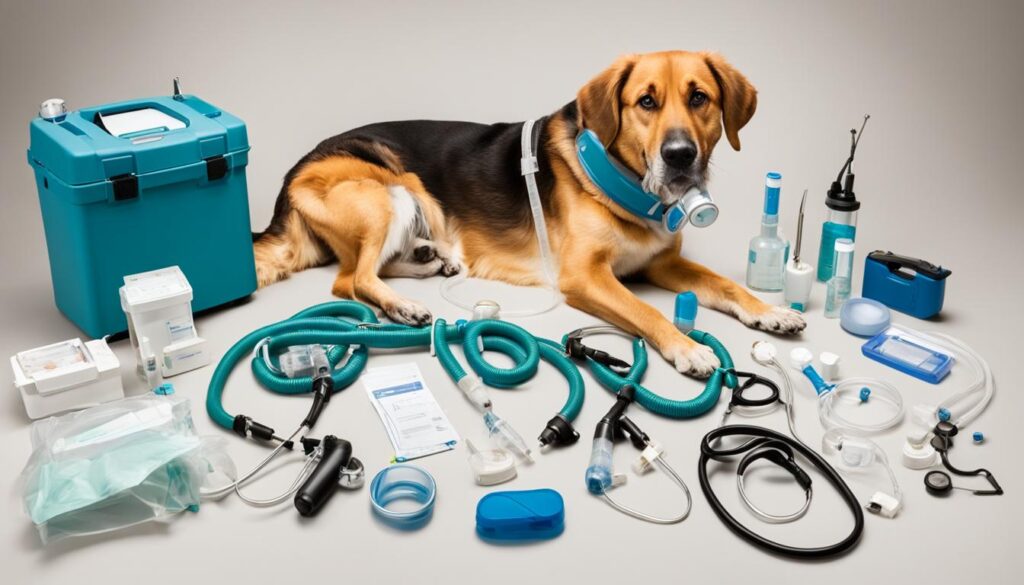Making the Decision: Euthanize a Dog with Tracheal Collapse
When your beloved dog is diagnosed with tracheal collapse, it can be an incredibly difficult and emotional journey. Tracheal collapse is a condition that affects the respiratory system of dogs, specifically the trachea, causing breathing difficulties and impacting their overall quality of life. As a pet owner, you may find yourself faced with the challenging decision of whether or not to euthanize your dog.
This decision should not be taken lightly and requires careful consideration of various factors. Understanding the signs and treatment options for tracheal collapse is crucial in making an informed decision that prioritizes the well-being of your furry friend.
Key Takeaways:
- Tracheal collapse in dogs can impact their quality of life, but many dogs can find relief through long-term management or surgery.
- Signs of tracheal collapse include a honking cough, difficulty breathing, and turning blue when worked up.
- Diagnostic tests such as x-rays and endoscopy can confirm a diagnosis of tracheal collapse.
- Treatment options include long-term management with medication, lifestyle changes, and surgical repair.
- The prognosis for dogs with tracheal collapse depends on various factors, and euthanasia may be considered in severe cases where the condition is not responsive to treatment.
Signs and Stages of Tracheal Collapse in Dogs
Tracheal collapse in dogs can manifest through various signs that depend on the severity of the condition. Some common signs include:
- A honking cough
- Difficulty breathing
- Coughing that worsens with activity or when pressure is applied to the neck
These symptoms can cause distress for dogs and may indicate the presence of tracheal collapse. To better understand the progression of the condition, tracheal collapse is classified into four stages:
| Stage | Description |
|---|---|
| Stage 1 | No or mild symptoms |
| Stage 2 | Moderate symptoms with partial collapse of the trachea during breathing |
| Stage 3 | Severe symptoms with the trachea collapsing during breathing |
| Stage 4 | Complete collapse of the trachea, leading to severe respiratory distress |
The stage of tracheal collapse can help determine the severity of the condition and guide treatment decisions. Early diagnosis and treatment are crucial to improve the prognosis for dogs with tracheal collapse.

The image above visually depicts the signs of tracheal collapse in dogs.
Treatment and Management Options for Tracheal Collapse
Tracheal collapse is a distressing condition that requires careful treatment and management to improve a dog’s quality of life. There are various options available, ranging from medication and lifestyle changes to surgical interventions.
Medication for Mild Cases
If your dog has a mild case of tracheal collapse, your veterinarian may recommend long-term management with medication. This can help control symptoms and reduce inflammation in the trachea. Common medications prescribed include:
- Steroids: These medications help decrease inflammation and can provide relief for dogs with tracheal collapse.
- Bronchodilators: These medications help relax the muscles around the airways, making breathing easier for your dog.
- Antitussives: These medications suppress coughing, which can be especially beneficial for dogs with a honking cough associated with tracheal collapse.
It’s important to follow your veterinarian’s instructions regarding dosage and administration of these medications.
Lifestyle Changes for Improved Quality of Life
In addition to medication, certain lifestyle changes can help manage tracheal collapse in dogs. These changes are aimed at minimizing stress on the trachea and improving your dog’s overall comfort. Consider the following:
- Switching from collars to harnesses: Collars can put pressure on the trachea and worsen symptoms. Opting for a harness can help distribute pressure more evenly.
- Avoiding triggers: Environmental factors such as heat, humidity, and air pollution can exacerbate symptoms. Take steps to minimize exposure to these triggers.
- Maintaining a healthy weight: Excess weight can put strain on the trachea. Ensure your dog is at a healthy weight to reduce the burden on their respiratory system.
By implementing these lifestyle changes, you can greatly improve your dog’s quality of life and reduce the frequency and severity of tracheal collapse symptoms.
Surgical Intervention
In more severe cases of tracheal collapse, where medication and lifestyle changes are not sufficient, surgical intervention may be necessary. The goal of surgery is to provide mechanical support to the trachea and prevent further collapse. Common surgical options include:
- Stent placement: A stent is a tube-like device inserted into the trachea to keep it open and provide stability.
- Ring placement: Rings made of durable materials, such as polypropylene, can be surgically placed around the trachea to provide support and prevent collapse.
Discuss with your veterinarian about the potential benefits and risks of surgical intervention for your dog. They will assess your dog’s individual case and determine if surgery is the best course of action.
Remember, every dog is unique, and what works for one may not work for another. It’s crucial to work closely with your veterinarian to develop a personalized treatment plan for managing tracheal collapse in your beloved canine companion.
| Treatment Options | Benefits | Considerations |
|---|---|---|
| Medication | – Controls symptoms – Reduces inflammation |
– Potential side effects – Long-term medication use |
| Lifestyle Changes | – Minimizes stress on trachea – Improves overall comfort |
– Requires adjustment period – Environmental limitations |
| Surgical Intervention | – Provides mechanical support – Prevents further collapse |
– Risks associated with surgery – Individual suitability |

Prognosis and Considerations for Euthanasia
The prognosis for dogs with tracheal collapse depends on various factors, including the severity of the condition, the presence of other health issues, and the effectiveness of treatment. With early diagnosis and appropriate management, many dogs with tracheal collapse can live a relatively normal life. However, severe cases or cases where the condition is not responsive to treatment may impact a dog’s quality of life.
In such cases, euthanasia may be considered to prevent further suffering. It’s important to consult with a veterinarian to assess the individual dog’s situation and make the best decision for their well-being.
Factors Affecting Prognosis
- Severity of tracheal collapse
- Presence of concurrent health issues
- Effectiveness of treatment
- Age and overall health of the dog
“The decision to euthanize a dog with tracheal collapse should always prioritize the dog’s quality of life. When symptoms become severe and impact daily activities, it may be necessary to consider euthanasia as a compassionate option.”
While it’s difficult to think about end-of-life decisions for our beloved pets, it’s essential to consider their well-being and prevent unnecessary suffering. Your veterinarian can provide guidance and support during this challenging time.
| Treatment Options | Pros | Cons |
|---|---|---|
| Long-term management with medications | – Can help control symptoms – Reduce inflammation – Improve quality of life |
– May require ongoing medication – Potential side effects |
| Lifestyle changes | – Switching to harnesses – Avoiding triggers – Improved comfort |
– Requires vigilance and adherence to lifestyle changes |
| Surgical repair | – Can provide long-term relief – Improves quality of life |
– Invasive procedure – Potential complications – Costly |

Remember, every dog is unique, and their response to treatment may vary. Regular communication with your veterinarian and close monitoring of your dog’s symptoms are crucial in making informed decisions regarding their care.
Conclusion
Tracheal collapse is a challenging and potentially debilitating condition that can greatly affect the quality of life for small breed dogs. While there are treatment options available, there may come a time when euthanasia is the most compassionate choice to prevent further suffering. It’s crucial to carefully consider the overall health, symptoms, and prognosis of the dog before making this difficult decision. Consulting with a veterinarian, who can provide expert guidance and support, is essential during this emotionally challenging time.
When faced with the decision of euthanizing a dog with tracheal collapse, it is important to prioritize the well-being and comfort of our furry friends. The impact of tracheal collapse on a dog’s daily life, including difficulties in breathing, coughing, and potential respiratory distress, cannot be overlooked. By working closely with a veterinarian, you can gain a comprehensive understanding of the dog’s condition and explore all available treatment options.
Ultimately, the decision to euthanize a dog with tracheal collapse should be made with empathy and compassion. Considering the overall quality of life and the dog’s ability to engage in normal daily activities, such as exercise and play, can help determine the most humane course of action. Remember to seek support from trusted professionals and loved ones to ensure you are making the best decision for your beloved pet.
FAQ
When should I consider euthanizing a dog with tracheal collapse?
The decision to euthanize a dog with tracheal collapse should be made after careful consideration of factors such as the dog’s overall health, symptoms, and prognosis. Consulting with a veterinarian can provide guidance and support during this difficult time.
What are the signs and stages of tracheal collapse in dogs?
Common signs of tracheal collapse in dogs include a honking cough, difficulty breathing, and worsening coughing with activity or pressure on the neck. Tracheal collapse is classified into four stages based on the progression of the condition, ranging from mild symptoms to severe respiratory distress.
What are the treatment and management options for tracheal collapse?
Treatment options for tracheal collapse can include long-term management with medication, such as steroids and bronchodilators, as well as lifestyle changes like using harnesses instead of collars and avoiding triggers. Surgical repair may also be necessary in more severe cases.
What is the prognosis for dogs with tracheal collapse and when is euthanasia considered?
The prognosis for dogs with tracheal collapse depends on factors such as the severity of the condition, the presence of other health issues, and the effectiveness of treatment. With proper management, many dogs can live a relatively normal life. However, in severe cases or when treatment is not effective, euthanasia may be considered to prevent further suffering.
Is tracheal collapse more common in small breed dogs?
Yes, tracheal collapse is more commonly seen in small breed dogs. Their smaller trachea size and weakened cartilage make them more susceptible to this condition. However, tracheal collapse can occur in dogs of any size.


